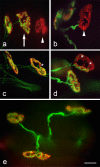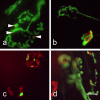Dynamic remodelling of synapses can occur in the absence of the parent cell body
- PMID: 17897464
- PMCID: PMC2048966
- DOI: 10.1186/1471-2202-8-79
Dynamic remodelling of synapses can occur in the absence of the parent cell body
Abstract
Background: Retraction of nerve terminals is a characteristic feature of development, injury and insult and may herald many neurodegenerative diseases. Although morphological events have been well characterized, we know relatively little about the nature of the underlying cellular machinery. Evidence suggests a strong local component in determining which neuronal branches and synapses are lost, but a greater understanding of this basic neurological process is required. Here we test the hypothesis that nerve terminals are semi-autonomous and able to rapidly respond to local stimuli in the absence of communication with their parent cell body.
Results: We used an isolated preparation consisting of distal peripheral nerve stumps, associated nerve terminals and post-synaptic muscle fibres, maintained in-vitro for up to 3 hrs. In this system synapses are intact but the presynaptic nerve terminal is disconnected from its cell soma. In control preparations synapses were stable for extended periods and did not undergo Wallerian degeneration. In contrast, addition of purines triggers rapid changes at synapses. Using fluorescence and electron microscopy we observe ultrastructural and gross morphological events consistent with nerve terminal retraction. We find no evidence of Wallerian or Wallerian-like degeneration in these preparations. Pharmacological experiments implicate pre-synaptic P2X7 receptor subunits as key mediators of these events.
Conclusion: The data presented suggest; first that isolated nerve terminals are able to regulate connectivity independent of signals from the cell body, second that synapses exist in a dynamic state, poised to shift from stability to loss by activating intrinsic mechanisms and molecules, and third that local purines acting at purinergic receptors can trigger these events. A role for ATP receptors in this is not surprising since they are frequently activated during cellular injury, when adenosine tri-phosphate is released from damaged cells. Local control demands that the elements necessary to drive retraction are constitutively present. We hypothesize that pre-existing scaffolds of molecular motors and cytoskeletal proteins could provide the dynamism required to drive such structural changes in nerve terminals in the absence of the cell body.
Figures






Similar articles
-
Axotomy-dependent and -independent synapse elimination in organ cultures of Wld(s) mutant mouse skeletal muscle.J Neurosci Res. 2004 Apr 1;76(1):64-75. doi: 10.1002/jnr.20016. J Neurosci Res. 2004. PMID: 15048930
-
Development of terminals and synapses in laminae I and II of the rat medullary dorsal horn after infraorbital nerve transection at birth.J Comp Neurol. 1997 Jul 7;383(3):339-48. J Comp Neurol. 1997. PMID: 9205045
-
Vestibular compensation after ganglionectomy: ultrastructural study of the tangential vestibular nucleus and behavioral study of the hatchling chick.J Neurosci Res. 2002 Jan 1;67(1):122-38. doi: 10.1002/jnr.10076. J Neurosci Res. 2002. PMID: 11754088
-
"Apoptotic" biochemical cascades in synaptic compartments: roles in adaptive plasticity and neurodegenerative disorders.J Neurosci Res. 1999 Oct 1;58(1):152-66. J Neurosci Res. 1999. PMID: 10491580 Review.
-
LTD, LTP, and the sliding threshold for long-term synaptic plasticity.Hippocampus. 1996;6(1):35-42. doi: 10.1002/(SICI)1098-1063(1996)6:1<35::AID-HIPO7>3.0.CO;2-6. Hippocampus. 1996. PMID: 8878740 Review.
Cited by
-
Loss of translation elongation factor (eEF1A2) expression in vivo differentiates between Wallerian degeneration and dying-back neuronal pathology.J Anat. 2008 Dec;213(6):633-45. doi: 10.1111/j.1469-7580.2008.01007.x. J Anat. 2008. PMID: 19094180 Free PMC article.
-
Morphological and bioenergetic demands underlying the mitophagy in post-mitotic neurons: the pink-parkin pathway.Front Aging Neurosci. 2014 Feb 18;6:18. doi: 10.3389/fnagi.2014.00018. eCollection 2014. Front Aging Neurosci. 2014. PMID: 24600391 Free PMC article. Review.
-
Bcl-x L increases mitochondrial fission, fusion, and biomass in neurons.J Cell Biol. 2009 Mar 9;184(5):707-19. doi: 10.1083/jcb.200809060. Epub 2009 Mar 2. J Cell Biol. 2009. PMID: 19255249 Free PMC article.
-
Characterization of early pathogenesis in the SOD1(G93A) mouse model of ALS: part I, background and methods.Brain Behav. 2013 Jul;3(4):335-50. doi: 10.1002/brb3.143. Epub 2013 Jun 11. Brain Behav. 2013. PMID: 24381807 Free PMC article.
-
Characterization of early pathogenesis in the SOD1(G93A) mouse model of ALS: part II, results and discussion.Brain Behav. 2013 Jul;3(4):431-57. doi: 10.1002/brb3.142. Epub 2013 Jun 11. Brain Behav. 2013. PMID: 24381813 Free PMC article.
References
-
- Lohof AM, Delhayebouchaud N, Mariani J. Synapse Elimination In the Central-Nervous-System – Functional- Significance and Cellular Mechanisms. Rev Neurosci. 1996;7:85–101. - PubMed
Publication types
MeSH terms
Grants and funding
LinkOut - more resources
Full Text Sources

